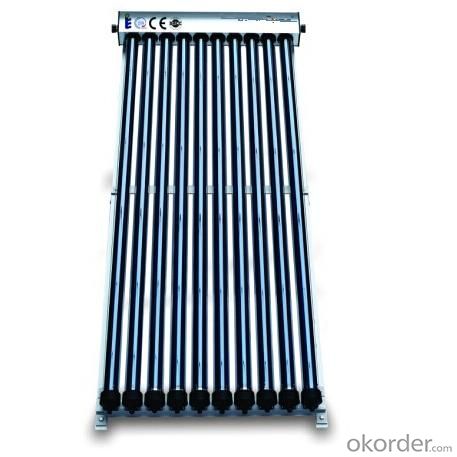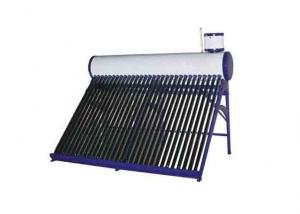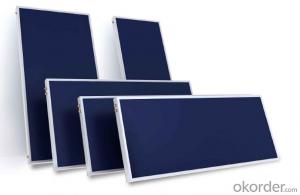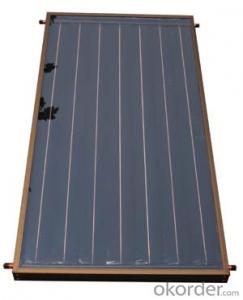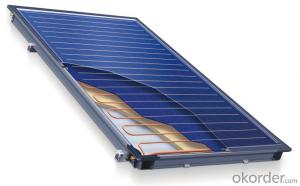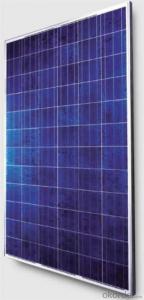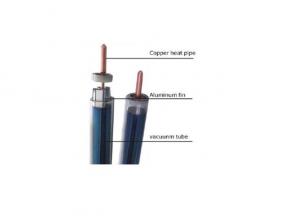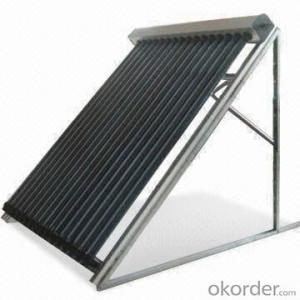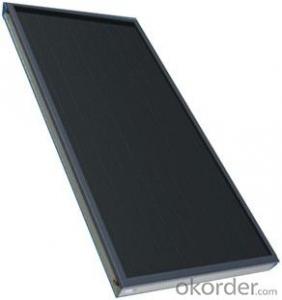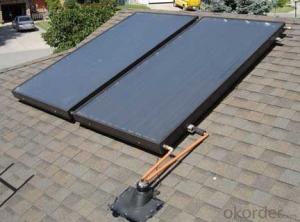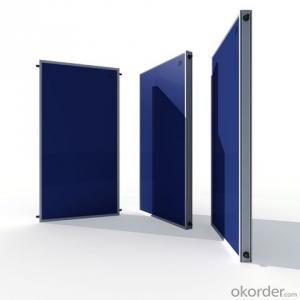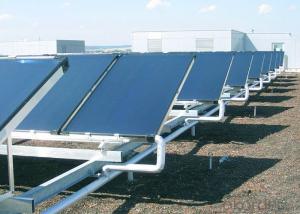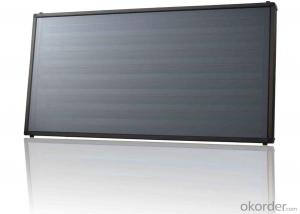I5 Solar Collectors Eccentric Heat Pipe Vacuum Tube SC-HE
- Loading Port:
- Shanghai
- Payment Terms:
- TT OR LC
- Min Order Qty:
- 20 set
- Supply Capability:
- 200 set/month
OKorder Service Pledge
OKorder Financial Service
You Might Also Like
1. Structure of Eccentric Heat Pipe Vacuum Tube Solar Collector Model SC-HE
This product is composed of the following parts:
1 Manifold 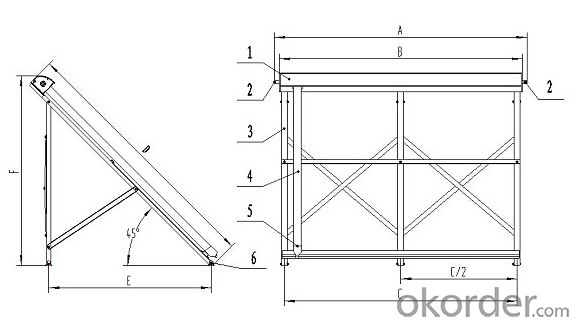
2 Collector Joint
3 All aluminum alloy shell and frame
4 All Glass Vacuum Tube , with reflection mirror sealed in
5 Tube Holder
6 Wind Feet
2. Main Features of Eccentric Heat Pipe Vacuum Tube Solar Collector Model SC-HE
Double ratio of light concentration, the temperature inside the tube is 30% higher than the normal tubes.
Superconducting copper heat pipe and large heat transfer area of the condensing end with high power of heat transfer and fast speed of start working.
The reflection mirror can avoid the effects from external environment and ensure that the mirror reflectivity is not reduced.
All aluminum alloy shell and frame with oxidation and coating anti-corrosion surface, corrosion resistance, easy to be installed.
The thermal insulation layer with rock wool/glass wool that can resistant high temperature, compression molding, high density, small coefficient of thermal conductivity.
Copper pipe with high purity and quality, pressure and corrosion resistance, can stand 1MPa.The gravity heat pipe transfers heat by one way, high heat collecting efficiency but low heat lost.
3. Eccentric Heat Pipe Vacuum Tube Solar Collector Model SC-HE Images
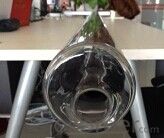
4. Eccentric Heat Pipe Vacuum Tube Solar Collector Model SC-HE Specifications
Model | SC-HCM-10 | SC-HCM-15 | SC-HCM-18 | SC-HCM-20 | SC-HCM-24 | SC-HCM-25 | SC-HCM-30 |
Tube Qty(pcs) | 10 | 15 | 18 | 20 | 24 | 25 | 30 |
Tube Pitch(㎜) | 90 | 90 | 90 | 90 | 90 | 90 | 90 |
Tube Diameter/ Length(㎜) | φ70/2000 | φ70/2000 | φ70/2000 | φ70/2000 | φ70/2000 | φ70/2000 | φ70/2000 |
Vacuum Tube Material | high borosilicate glass 3.3 | high borosilicate glass 3.3 | high borosilicate glass 3.3 | high borosilicate glass 3.3 | high borosilicate glass 3.3 | high borosilicate glass 3.3 | high borosilicate glass 3.3 |
Thickness of Inner Tube/Outer Tube(㎜) | 1.6/2.0 | 1.6/2.0 | 1.6/2.0 | 1.6/2.0 | 1.6/2.0 | 1.6/2.0 | 1.6/2.0 |
Condensator Diameter/ Length(㎜) | φ14/1900 | φ14/1900 | φ14/1900 | φ14/1900 | φ14/1900 | φ14/1900 | φ14/1900 |
Heat Pipe Material / Thickness(㎜) | Copper tp2/0.6 | Copper tp2/0.6 | Copper tp2/0.6 | Copper tp2/0.6 | Copper tp2/0.6 | Copper tp2/0.6 | Copper tp2/0.6 |
Copper Pipe Diameter/ Thickness | φ35/1.0 | φ35/1.0 | φ35/1.0 | φ35/1.0 | φ35/1.0 | φ35/1.0 | φ35/1.0 |
Joint Specification | φ22 Or 3/4″ | φ22 Or 3/4″ | φ22 Or 3/4″ | φ22 Or 3/4″ | φ22 Or 3/4″ | φ22 Or 3/4″ | φ22 Or 3/4″ |
Insulation Material/ Thickness(㎜) | Rock Wool/40 | Rock Wool /40 | Rock Wool /40 | Rock Wool/40 | Rock Wool /40 | Rock Wool /40 | Rock Wool /40 |
Rated Pressure(MPa) | 0.6 | 0.6 | 0.6 | 0.6 | 0.6 | 0.6 | 0.6 |
Working Temperature(℃) | <120 | <120 | <120 | <120 | <120 | <120 | <120 |
Capacity(L) | 0.89 | 1.26 | 1.48 | 1.63 | 1.93 | 2.00 | 2.37 |
Collecting Area(㎡) | 1.37 | 2.05 | 2.46 | 2.73 | 3.28 | 3.41 | 4.10 |
Gross Area(㎡) | 2.01 | 2.98 | 3.56 | 3.95 | 4.72 | 4.91 | 5.88 |
Referral Traffic(L/min) | 1.06 | 1.49 | 1.79 | 2.0 | 2.4 | 2.5 | 3.0 |
Pressure Drop(Pa) | 16.24 | 41.4 | 63.4 | 81.7 | 127.2 | 140.1 | 219.8 |
Intercept Efficiencyη0 | 0.77 | 0.77 | 0.77 | 0.77 | 0.77 | 0.77 | 0.77 |
Heat Loss Coefficient a W/㎡℃ | 1.9 | 1.9 | 1.9 | 1.9 | 1.9 | 1.9 | 1.9 |
Powe(W)1000W/㎡Irradiation | 744 | 1044 | 1256 | 1398 | 1681 | 1748 | 2098 |
40.25 | 52.75 | 61.75 | 66.75 | 81.00 | 85.35 | 100.70 | |
a (㎜) | 1115 | 1615 | 1915 | 2115 | 2515 | 2615 | 3115 |
b (㎜) | 1025 | 1525 | 1825 | 2025 | 2425 | 2525 | 3025 |
c (㎜) | 950 | 1450 | 1750 | 1950 | 2350 | 2450 | 2950 |
c/2 (㎜) | —— | —— | 875 | 975 | 1175 | 1225 | 1475 |
d (㎜) | 2150 | 2150 | 2150 | 2150 | 2150 | 2150 | 2150 |
e (㎜) | 1375 | 1240 | 1240 | 1240 | 1240 | 1240 | 1240 |
f (㎜) | 1590 | 1590 | 1590 | 1590 | 1590 | 1590 | 1590 |
5. FAQ
1. Can the solar collector be used in cold condition?
Re: This solar collectors can be used in temperatures as low as -30℃, although performance is greatly reduced in such extreme conditions. Good heat output is still achieved in mild sub-zero conditions.
2. What maintenance of the solar collector is required?
Re: Under normal circumstances no maintenance of the system is required. Due to the shape of the tubes regular rainfall and wind should keep the tubes clean. Should a tube even be broken it should be replaced. This, however, is an inexpensive and easy job. Any "handy" person can install a new tube (while adhering to local health and safety regulations). Our solar collectors can operate with several broken tubes, however the efficiency will be reduced slightly.
- Q: Can solar collectors be used for heating orchards?
- Yes, solar collectors can be used for heating orchards. Solar thermal systems can capture solar energy and convert it into heat, which can then be used for various purposes, including heating orchards. By utilizing solar collectors, orchard owners can reduce their reliance on fossil fuels and lower heating costs while maintaining optimal growing conditions for their crops.
- Q: Can solar collectors be used for charging batteries?
- Yes, solar collectors can be used for charging batteries. Solar panels, also known as solar collectors, convert sunlight into electrical energy, which can be used to charge batteries. This process, known as solar charging, is a sustainable and environmentally friendly way to power various devices and systems that rely on batteries.
- Q: Can solar collectors be used for heating nursing homes?
- Yes, solar collectors can be used for heating nursing homes. Solar thermal systems can provide hot water and space heating for nursing homes by harnessing the sun's energy and converting it into heat. This can help reduce energy costs and lower carbon emissions while providing a sustainable heating solution for these facilities.
- Q: Can solar collectors be used for heating train stations and public transportation terminals?
- Solar thermal collectors, also referred to as solar collectors, have the ability to heat train stations and public transportation terminals. These collectors absorb sunlight and convert it into heat energy. This heat can then serve various purposes, including space heating. Train stations and transportation terminals are typically substantial structures with high heating requirements. The installation of solar collectors on the roof or nearby areas enables the utilization of solar energy to warm these facilities. There exist diverse types of solar collectors suitable for this purpose, such as flat-plate collectors and evacuated tube collectors. These collectors consist of tubes or panels that contain a heat transfer fluid. Sunlight heating the collectors causes the fluid to warm up, which is subsequently circulated through a heat exchanger. The heat is then transferred to the building's heating system. Employing solar collectors for heating train stations and public transportation terminals presents numerous benefits. Firstly, it is an environmentally friendly and sustainable energy source that reduces reliance on fossil fuels and minimizes greenhouse gas emissions. Secondly, it aids in cost reduction, as solar energy is abundant and free. Additionally, solar collectors necessitate minimal maintenance and have a long lifespan, making them a cost-effective long-term heating solution. However, specific factors must be taken into consideration when utilizing solar collectors for large facilities' heating purposes. The size and quantity of collectors must be carefully calculated to match the heating requirements of the train station or terminal. Furthermore, the positioning and orientation of the collectors should be optimized to maximize exposure to sunlight and energy absorption. In conclusion, solar collectors are indeed a viable option for heating train stations and public transportation terminals. They provide a sustainable and cost-effective heating solution, contributing to the reduction of environmental impact and energy expenses. With appropriate design and installation, solar collectors can effectively satisfy the heating needs of these facilities.
- Q: Are there any safety concerns associated with solar collectors?
- Yes, there are a few safety concerns associated with solar collectors. One concern is the risk of overheating and potential fires if the system is not installed or maintained properly. Additionally, there is a risk of electric shock during installation or maintenance if proper precautions are not taken. It is important to follow safety guidelines and have professionals handle the installation and regular maintenance of solar collectors to minimize these risks.
- Q: Can solar collectors be used for heating hotels?
- Yes, solar collectors can be used for heating hotels. Solar thermal collectors can be installed on the roof or in open spaces to capture sunlight and convert it into heat energy. This heat energy can then be used to provide hot water or space heating for hotels, reducing their reliance on traditional heating methods and decreasing their carbon footprint.
- Q: Can solar collectors be used in swimming pools?
- Yes, solar collectors can be used in swimming pools to heat the water using the sun's energy.
- Q: Can solar collectors be used for heating art galleries?
- Yes, solar collectors can be used for heating art galleries. Solar collectors, such as solar thermal panels, can harness the sun's energy to heat water or air. This heat can then be used to warm the interior of art galleries, providing a sustainable and cost-effective solution for maintaining optimum temperature and climate conditions for preserving artwork.
- Q: Can solar collectors be used in biomass power plants?
- Solar collectors can indeed be employed in biomass power plants, which can ultimately improve the facility's efficiency and sustainability. By integrating solar collectors into biomass power plants, the overall effectiveness and environmental impact of the facility can be enhanced. Utilizing solar collectors enables the provision of supplementary heat to the biomass combustion process, thereby elevating energy output and decreasing dependence on fossil fuels. This integration allows for a consistent and dependable energy supply, as solar energy can be tapped into even during fluctuations in biomass fuel availability. Moreover, employing solar collectors in biomass power plants aids in reducing greenhouse gas emissions and mitigating the facility's environmental consequences. Ultimately, the combination of solar collectors and biomass power plants creates a more efficient and sustainable energy generation system.
- Q: Can solar collectors be used in areas with limited access to technical standards?
- Yes, solar collectors can be used in areas with limited access to technical standards. Solar collectors are relatively simple and straightforward in design and operation. They do not require complex technical standards for installation or maintenance. In fact, solar collectors can often be easily installed and maintained by local communities with basic technical knowledge and training. This makes them a viable and sustainable option for generating clean energy in areas with limited access to technical standards.
Send your message to us
I5 Solar Collectors Eccentric Heat Pipe Vacuum Tube SC-HE
- Loading Port:
- Shanghai
- Payment Terms:
- TT OR LC
- Min Order Qty:
- 20 set
- Supply Capability:
- 200 set/month
OKorder Service Pledge
OKorder Financial Service
Similar products
Hot products
Hot Searches


